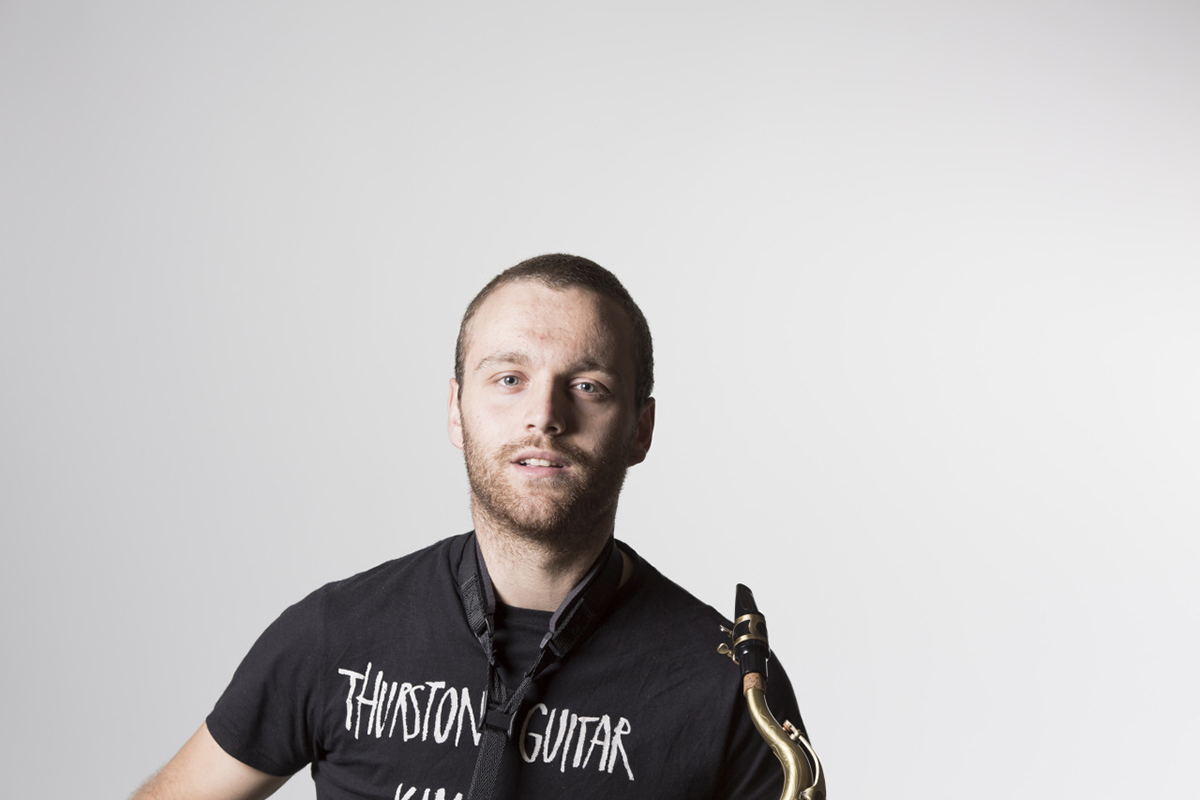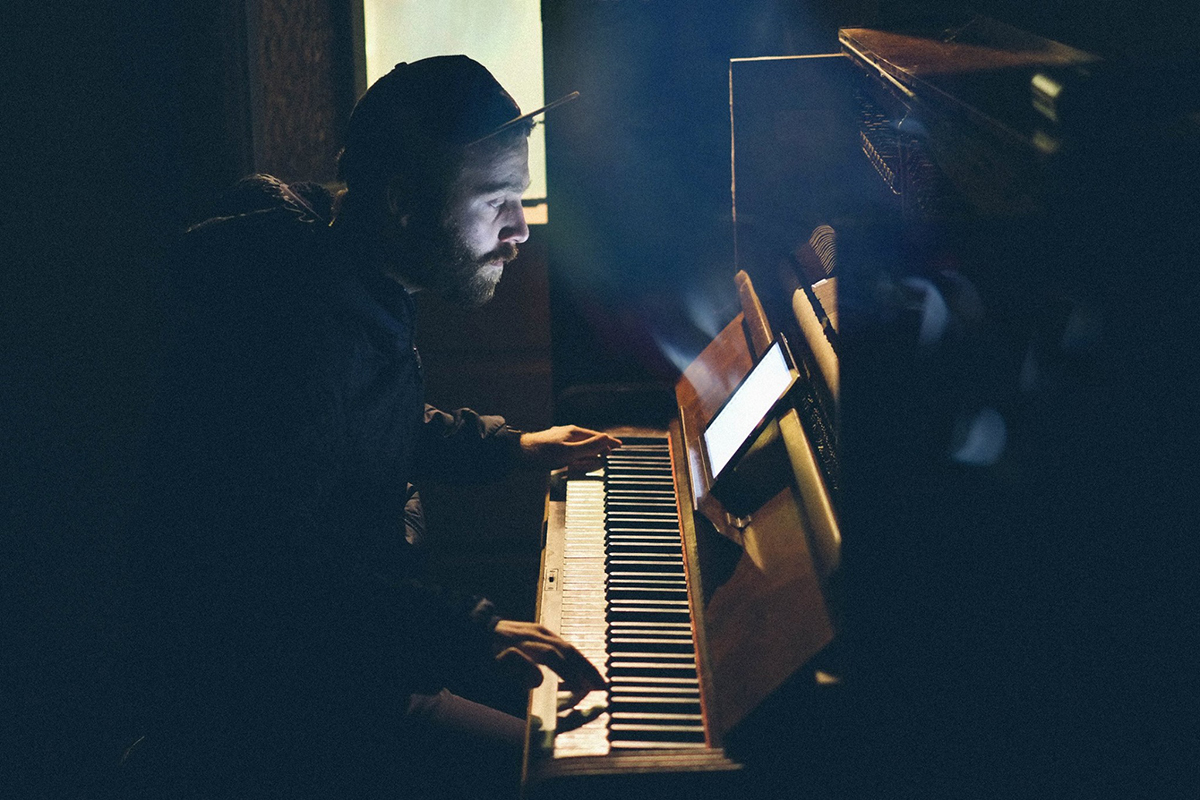
Dan Thorpe: energy, artistry, queer resistance
Dan Thorpe, 2016 winner of the inaugural APRA-AMCOS Art Music Fund Award and, in the same year, winner of the Adelaide Critics’ Circle’s emerging performer award, is establishing himself as an innovative and accomplished composer and performer, nationally and internationally. In 2015, he devised and performed the music and produced an accompanying video for Concrete Collective’s dance work personwhowatchestoomuchtelevision (see the 2015 RealTime review) and then successfully toured the production to the USA. He has released a number of albums, received significant commissions and frequently collaborates with other musicians and composers.
Education, thesis, teaching
A classically-trained pianist and piano teacher, Thorpe graduated in 2013 with a first class honours in Sonic Arts and Composition at the Elder Conservatorium in the University of Adelaide, where he is completing a Master of Philosophy degree. His thesis is titled “Desiring Machines — Queering Methodologies in Reactive Performance.” In the exegesis he discusses performer interactivity with musical software used in performance and considers whether that interaction can be proactive rather than reactive.
He notes that the currently accepted paradigm, based on performer reactivity to a pre-determined design, symbolises institutional control more broadly. “There is a queer necessity to imagine and enact possible futures outside of these limits, to explore the not-here-yet, of which queerness offers us a glimpse.” In devising software that is “editable, extensible and manipulable” by users, he indicates he is developing “a personal, queer resistance to this technological and social paradigm.” As part of the project, he has devised software that draws scores based on input from the performers as they perform. For example, in personwhowatchestoomuchtelevision, the dancers wore accelerometers that traced their movements and generated a graphic score for the accompanying musician. The musician thus follows the dancer — instead of the dancer’s body being controlled, the body exerts control.
Thorpe currently teaches an industry readiness class on digital production in the Popular Music and Creative Technologies program at the Conservatorium and is a tutor in the University’s Indigenous Tutorial Assistance Scheme. He is also working as copyist/composer’s assistant on a new opera Speechless from Cat Hope (Head of the Sir Zelman Cowan School of Music at Monash University) which was recently workshopped at Vitalstatistix in Port Adelaide.

personwhowatchestoomuchtelevision, photo Huw Trenoarden
In concert at Format Gallery
In June, Thorpe completed a five-week residency involving weekly concerts at Adelaide’s Format Gallery, a key venue for contemporary music and art. In the first, he performs solo on his own well-used upright piano that has been wheeled into the gallery’s café, off busy, noisy Hindley Street. There are two works: California Fragments and Homecoming (three years later), both for prepared piano and electronics. Thorpe introduces them by saying they are born of sadness and pain — these are very personal pieces. California Fragments is quiet and introspective, performed with exaggerated physical gestures that contrast with the gentle music, as if he’s conveying multiple emotional states simultaneously. Such work seems intended for a small, intimate setting or private contemplation, and the piano seems an extension of his persona. But the electronically mediated sound is a crucial element — it’s as if his thoughts have been recorded and broadcast in parallel with his playing. Thorpe combines the two kinds of sound artfully, the juxtaposition of the aging piano, which symbolises a long musical tradition, with the newest electronic media offering a metaphor for cultural dissonance and transition. These works are more than musical, more than personal and consider contemporary musical culture and aural cognition.
For concert three, Thorpe, on piano, electronics and electronic keyboards, is joined by Mat Morison on sampler, electronics, synths and vocals in two half-hour sets of high-energy free improvisation. During the interval, he tells me that the second set will be “more ethereal” than the first, but after starting off that way the dynamism builds again, seeming to grow organically. For the second set, Thorpe removes the front of the piano so he can dampen the strings with his fingers. He hits the keys with such vigour that he bruises his hand — performance seems a cathartic experience for him. Thorpe and Morison make magic together, creating a long, elaborate dialogue across sonic forms, each offering musical gestures or phrases to which the other responds to weave a dense tapestry of sound, with Thorpe throwing in fragments from classical composers, again artfully mixing traditions and genres. The audience filling the small café sits enraptured.
The fourth concert comprises a thoughtful selection of works by a range of significant composers, including Anne Boyd’s Angklung for piano, Missy Mazzoli’s Orrizonte for piano and electronics, Erik Griswold’s delightfully evocative Bellbirds (Mt Nebo) for piano, Alex Temple’s Inland for piano and melodica, with Thorpe playing both instruments simultaneously, and Cat Hope’s Chunk, an overwhelmingly intense work involving two simultaneously realised graphic scores, one for piano and one for disklavier, performed by Thorpe on piano and computer. He is joined by Melanie Walters (flute), with whom he often collaborates, to perform a version of his own work False Cognate, for bass flute and electronics, and he finishes the set with Sydney composer Kezia Yap’s Lightjar which he commissioned from her, a delightful piece for piano and electronics.
Through the PA, Thorpe later broadcast his Debussy Remixes, for which he electronically morphed out-of-copyright recordings of Debussy’s piano music, thus filtering traditional piano literature through new media. It’s like listening to someone else’s experience of listening to or remembering Debussy. Debussy Remixes can also be seen as a metaphor for the changing nature of musical composition, performance and transmission, which involve appropriation and re-presentation.
Throughout his Format residency, Dan Thorpe illustrated the potential for performers to work interactively, both with software technologies and with each other, within various compositional frameworks. His residency also brought to Adelaide works that might not otherwise be performed, and especially showcased his own compositional interests, philosophy and energetic and innovative approach to performance.

Dan Thorpe, photo Broken Chip
The interview
Firstly, you perform a wide range of music — solo piano, solo electronica, ensemble performance of various kinds, and you have collaborated in 2015 with Concrete Collective in a dance work. Are there particular fields of music and performance that interest you? What are you focusing on in the near future?
In the near future and, also, in the past and present of my career what interests me is storytelling. I think there’s plenty of genres you can do that through, and maybe that’s the question you’re asking, but for me the story is primary. And I guess how I tell them depends on the story in question! At the moment, I’m working on pieces for the MSO’s Cybec Program, Decibel Ensemble and Gabriella Smart. As for what they’re about, I’ll have to cheekily suggest you come along and listen! I’m also constantly writing for myself, and nothing has changed there.
Do you think the Adelaide contemporary music scene, and the Australian scene, offer adequate support to young composers who are developing new music? You have performed in San Diego, Los Angeles and New York — is there more public support, more receptiveness to new music elsewhere?
I can say, in my case, I feel very supported by my colleagues and audiences; but materially making ends meet as a young artist is so far from possible. I feel like there are limited opportunities, but not particularly through the fault of any organisations or audiences than an across-the-board failure by governments in this country to show anything other than utter contempt for young people, culture and the future of the country on any level, not just in our little pond of dissatisfaction in the arts.
As for the States, well, this is a tricky thing to talk about without acknowledging that my experience of the US is as a touring artist. I feel like my conversations with young composers are very polarised… the rich ones, certainly, still struggle existentially but as for the ones from the equivalents of Adelaide’s outer-north, my home turf…? It honestly feels like the stakes (and chance of failure) are higher, but for some the pay-off far surpasses what we would ever consider here. There’s certainly a public, and a culturally engaged one, in major urban centres; but these also exist in Australia.
You said your music comes from the body, and some of your work at the Format residency has been very personal. Is this intuitive approach effective aesthetically?
I think we need to talk about the idea of intuitiveness. There’s very little about a queer body that is intuitive, because we’re taught about our bodies through overwhelmingly straight frames. I would argue that my work that deals with my body is my most exploratory; I use the privilege of making art to find new ways of expressing and understanding my body in a society where that sort of understanding is meant to be suppressed.
As for the aesthetic effect… I mean, it’s not primary for me. I want to give audiences a sensation of what it’s like to be in a queer body when I perform my work. I want to invite them, through my own vulnerability, to be vulnerable. A dear (queer) friend once described this, jokingly, as being a “messy faggot,” which is something I’ve become fond of. I think there’s traditional, masculine expectation to be a certain degree of emotionally/sexually/physically ‘tidy.’ I want to invite audiences to be messy with me, to allow contrary feelings to exist at the same time, to allow their bodies to contain questions instead of answers, to find catharsis in the way the work discomforts them. Maybe that’s how a queer body feels, maybe it’s just how I want to feel about my queer body; it’s kind of immaterial, both can exist simultaneously and maybe it’s important that they do.
You spoke of the connection between music and sexuality. Is there a new music scene based around sexuality and is the aesthetic different? When you write or perform, are you addressing a particular audience?
Queerness is something that’s thrust on us by a society concerned that we’re not straight; making a decision to own an identity that should mark you for exclusion is bound to create community. Whether there’s a specific queer new music scene is vaguely like asking if the Gay Agenda is a Google group… queer people go to things that speak to their experience because very little does; maybe some of my audience comes for that reason. Maybe some of my audience comes because they want to hear something that makes them think but they’re pretty repelled by the politics of the aristocracy that define concert halls. Maybe some just like coming to the pub and I’m an added bonus/inconvenience. That said, if someone wants to start the Gay Agenda mailing list, sign me up.
Has the Format residency been valuable for your own development as a composer and performer?
Sure! I love to play, and I especially love to play with my friends, and Format gave me an incredible opportunity to do that. The residency itself also gave me a chance to reflect on my Carclew-funded trip to the States, where I wrote a lot of the work I premiered during my residency. I think it’s safe to say that having time, space and money to explore your practice is the most important thing any young artist can have access to, and I’m incredibly grateful to Carclew for the opportunity they provided by funding me.
–
Read more about Dan Thorpe, including his albums, at www.danthorpe.net. Information about courses and degrees at The University of Adelaide’s Elder Conservatorium can be found here.
Top image credit: Dan Thorpe, photo Dennis Grauel






